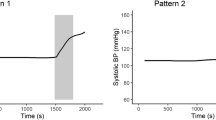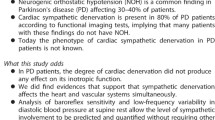Abstract
Introduction
Dysautonomia is a characteristic finding in Guillain-Barré syndrome (GBS). Sinus tachycardia, blood pressure instability, sustained hypertension or hypotension, cardiac arrhythmias, sweating abnormalities, gastrointestinal or urogenital symptoms, and neurogenic stunned myocardium have been previously described in patients with GBS. To our knowledge, increased intrapulmonary shunts in association with GBS have not yet been reported.
Methods
We present a case of GBS with severe dysautonomia associated with clinical relevant intrapulmonary shunts. Autonomic functions were tested using baroreflex sensitivity and heart rate variability measures. Intrapulmonary shunts were calculated according to the Berggren formula.
Results
Autonomic functions showed excessive sympathetic activation. Intrapulmonary shunts were increased up to six times compared to the norm. Other causes of increased intrapulmonary shunts, such as sepsis, pulmonal or cardiac complications, were excluded during hospitalization.
Conclusion
Intrapulmonary shunts in GBS may relate to sympathetic overactivation and should be anticipated in GBS patients with unexplained respiratory deterioration.
Similar content being viewed by others
References
Winer JB, Hughes RA. Identification of patients at risk of arrhythmia in the Guillain-Barré syndrome. Q J Med. 1988;68:735–9.
Bernstein R, Mayer SA, Magnano A. Neurogenic stunned myocardium in Guillain-Barré syndrome. Neurology. 2000;54:759–62.
Finkelstein JS, Melek BH. Guillain-Barré syndrome as a cause of reversible cardiomyopathy. Tex Heart Inst J. 2006;33:57–9.
Pfeiffer G. Dysautonomia in Guillain-Barré syndrome. Nervenarzt. 1999;70:136–48.
Ahmad J, Kham AS, Siddiqui MA. Estimation of plasma and urinary catecholamines in Guillain-Barré syndrome. Jpn J Med. 1985;24:24–9.
Ventura HO, Messerli FH, Barron RE. Norepinephrine-induced hypertension in Guillain-Barré syndrome. J Hypertens. 1986;4:265–7.
Berggren SM. The oxygen deficit of arterial blood caused by non-ventilating parts of the lung. Acta Physiol Scand Suppl. 1942;4:1–92.
Tahvanainen J, Meretoja O, Nikki P. Can central venous blood replace mixed venous blood samples? Crit Care Med. 1982;10:758–61.
Ladakis C, Myrianthefs P, Karabinis A, Karatzas G, Dosios T, Fildissis G, et al. Central venous and mixed venous oxygen saturation in critically ill patients. Respiration. 2001;68:279–85.
Marx G, Reinhart K. Venous oximetry. Curr Opin Crit Care. 2006;12:263–8.
Westerhof BE, Gisolf J, Stok WJ, Wesseling KH, Karemaker JM. Time-domain cross-correlation baroreflex sensitivity: performance on the EUROBAVAR data set. J Hypertens. 2004;22:1371–80.
Heart rate variability: standards of measurement, physiological interpretation and clinical use. Task Force of the European Society of Cardiology and the North American Society of Pacing and Electrophysiology. Circulation. 1996;93:1043–65.
Fei L, Copie X, Malik M, Camm AJ. Short- and long-term assessment of heart rate variability for risk stratification after acute myocardial infarction. Am J Cardiol. 1996;77:681–4.
Flachenecker P, Hartung HP, Reiners K. Power spectrum analysis of heart rate variability in Guillain-Barré syndrome. A longitudinal study. Brain. 1997;120(Pt 10):1885–94.
Asahina M, Kuwabara S, Suzuki A, Hattori T. Autonomic function in demyelinating and axonal subtypes of Guillain-Barré syndrome. Acta Neurol Scand. 2002;105:44–50.
Yamamoto T, Tamura N, Nakazato Y, Itokawa K, Maeda A, Abe T, et al. A study of parasympathetic functions in Guillain-Barré syndrome. Rinsho Shinkeigaku. 2002;42:126–30.
Eldridge MW, Dempsey JA, Haverkamp HC, Lovering AT, Hokanson JS. Exercise-induced intrapulmonary arteriovenous shunting in healthy humans. J Appl Physiol. 2004;97:797–805.
Stickland MK, Welsh RC, Haykowsky MJ, Petersen SR, Anderson WD, Taylor DA, et al. Intra-pulmonary shunt and pulmonary gas exchange during exercise in humans. J Physiol. 2004;561:321–9.
Durocher A, Servais B, Caridroix M, Chopin C, Wattel F. Autonomic dysfunction in the Guillain-Barré syndrome. Hemodynamic and neurobiochemical studies. Intensive Care Med. 1980;6:3–6.
Dalos NP, Borel C, Hanley DF. Cardiovascular autonomic dysfunction in Guillain-Barré syndrome. Therapeutic implications of Swan-Ganz monitoring. Arch Neurol. 1988;45:115–7.
Kaye AD, Hoover JM, Baber SR, Ibrahim IN, Fields AM. Effects of norepinephrine on alpha-subtype receptors in the feline pulmonary vascular bed. Crit Care Med. 2004;32:2300–3.
Ideguchi M. Experimental studies on the effect of total thoracic esophagectomy on cardiorespiratory functions and the plasma concentration of chemical mediators. Jpn J Surg. 1991;21:75–87.
Shima I. The preserving effects of bronchial arteries and pulmonary nerves at radical esophagectomy on cardio-respiratory functions in dogs. Nippon Kyobu Geka Gakkai Zasshi. 1989;37:2305–17.
Reinhart K, Kuhn HJ, Hartog C, Bredle DL. Continuous central venous and pulmonary artery oxygen saturation monitoring in the critically ill. Intensive Care Med. 2004;30:1572–8.
Dueck MH, Klimek M, Appenrodt S, Weigand C, Boerner U. Trends but not individual values of central venous oxygen saturation agree with mixed venous oxygen saturation during varying hemodynamic conditions. Anesthesiology. 2005;103:249–57.
Author information
Authors and Affiliations
Corresponding author
Rights and permissions
About this article
Cite this article
Sykora, M., Diedler, J., Hacke, W. et al. Intrapulmonary Right-Left Shunts in Guillain-Barré Syndrome with Severe Dysautonomia. Neurocrit Care 9, 374–377 (2008). https://doi.org/10.1007/s12028-008-9101-z
Published:
Issue Date:
DOI: https://doi.org/10.1007/s12028-008-9101-z




